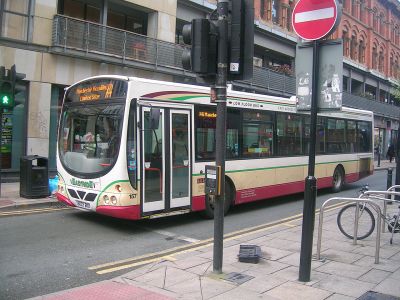
Rossendale Transport bus in Manchester
By Mikey from Wythenshawe, Manchester, UK (Oldham Street, Manchester Uploaded by Ultra7) [CC BY 2.0 (http://creativecommons.org/licenses/by/2.0)], via Wikimedia Commons
Interchanges where passengers can switch from one public transport route to another more safely, reliably and comfortably benefit the mobility needs of European society overall. An EU initiative is looking to make urban transport interchanges more efficient and sustainable.
Efficient urban networks can allow for the seamless use of different
means of transport. The majority of today's urban interchanges are not
optimised enough, thus failing to meet the needs and demands of modern
commuters, especially women, the elderly and persons with disabilities.
To achieve effective and sustainable urban transport interchanges, the EU-funded
CITY-HUB
project is creating solutions to maximise coordination, information
systems and business models. The focus is on the design of an integrated
business model that takes into account all aspects of urban
interchange.
During the first reporting period, the project team evaluated
present circumstances in urban interchanges, identified the main actors
and their roles, and carried out stakeholder interviews and commuter
surveys. It validated and tested the main factors that affect
interchange, such as efficient planning and design, accessibility,
convenience and safety.
Case studies identified best practices, and obstacles to and areas for improvement.
Researchers used the analysis of the current state of play and the
results of the case studies as a starting point in the development of an
efficient and smart design model for transport interchanges. They also
assessed the operations, management, interconnectivity, information
services and efficiency of urban transport interchanges.
All the outcomes will be used in the second reporting period to
deliver a complete set of methodological guidelines for integrating
design and management models.
By proposing solutions for sustainable planning and design, CITY-HUB
intends to contribute to smarter, cleaner and safer urban transport
interchanges.

